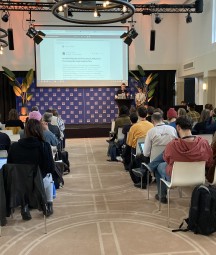On the 3rd of November, the National Library of Ireland (NLI) marked World Digital Preservation Day by leading an in-person workshop on the appraisal, description and generation of technical reports about born-digital photographic collections. The title of the workshop was Focus on Digital : An introduction to working with born-digital photographic collections.
In this post, we’ll describe what is unique about born-digital material, how the day to day work of the NLI Digital Collections department influenced the content of the workshop, as well as details of the workshop itself.
When we say born-digital, we mean that the files originated in digital form, rather than being the product of digitisation. Examples are Word Documents, digital photographs, websites or even spreadsheets. Born-digital material brings a unique series of challenges and opportunities. Many cultural institutions, including the NLI have a long history of digitisation and may have advanced, automated procedures for ingesting digitised material into a digital repository and making it accessible to the public. However, born-digital collections can require staff up-skilling and technical upgrades to systems beyond those already in place for digitisation.
On the surface, working with born-digital photography seems very similar to digitised photographs as they’re both image based, but there are many differences. With digitisation, the collecting institution either creates or commissions the digital files from existing physical holdings, for example a digitised map or manuscript, but with born-digital, the creator or donor will create a digital thing/file/object. When digitising, you can dictate the quality of the photograph, the file format and file size, but with born-digital collections, you often have to accept whatever the photographer has created. Another challenge is that with the advent of digital cameras and large storage devices, it’s possible to create many photographs per second, so there is the potential for tens, if not hundreds of very similar photographs taken within the timespan of a few minutes. A major opportunity arising from born digital photographs is that the camera, the photographer, or the editing software (Lightroom/Photoshop) can embed all sorts of metadata in the file itself, which can aid with knowing a lot more about the photograph, and getting essential information like when the photograph was taken, or who took it.
Attendees of the workshop were led through three separate sessions with a mix of presentations and exercises that furthered their knowledge of working with these kinds of collections, all based on the practical experience of NLI staff. Each session covered a different topic, including appraisal, description and the generation of technical reports. As we wanted the workshop to be interactive and practical, we created a data set of test files for use in the exercises as part of each session. The test files that we used for the workshop included photographs from a variety of iPhones, as well as from DSLR cameras (Digital Single Lens Reflex). As part of working with the Yes Equality Photographic Collection, the NLI had to use existing skillsets and processes, adapt them to born-digital material, and use digital preservation tools to analyse the files in order to support this work.

The event was hosted by Maria Ryan, who guided attendees through the itinerary of the day. First up was Della Keating discussing appraisal in the context of born digital photographic material. She highlighted the benefit of using existing appraisal policy and processes as building blocks for appraisal of digital content and the opportunities for more granular appraisal of born digital photographs using visual and technical appraisal techniques. Next up was Kieran O’Leary who talked attendees through the process of creating technical reports using ExifTool. These reports were the same reports that Della used in her appraisal exercise, and they generated spreadsheets with substantial metadata that the camera, editing tool or photographer had created. Finally, Joanna Finegan looked at how the library created item (ie. photograph) level records at scale by using metadata from technical reports. Participants then created their own record template/profile for at scale description by identifying relevant embedded metadata from the same Exiftool report which Della and Kieran used. Then they used their template to create a record describing a sample photograph from the test collection.

We were delighted with the engagement with the exercises and the observations made by attendees. It was a change of approach from our usual World Digital Preservation Day events, as previous events took the form of a series of presentations where members of the community shared their experiences and learnings of working with born digital collections rather than hands-on workshops. The NLI is looking forward to continuing to join the many other institutions around the world to celebrate World Digital Preservation Day, so keep an eye out later in the year for our 2023 event!


